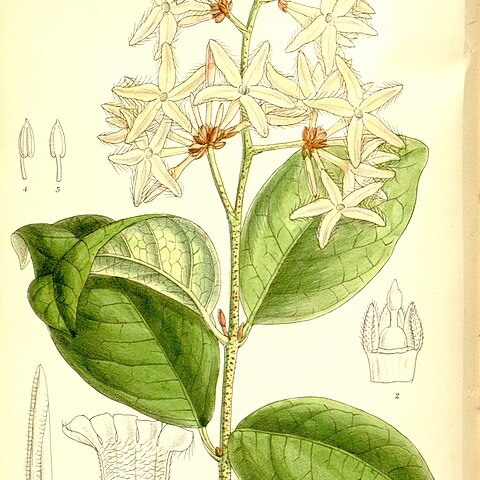Woody climber. Stems many, seldom branched, young stems with fine rusty or white hairs, older stems dark brown with white hairs, becoming glabrescent, hairs long, crisped, with many small, often raised lenticels. Leaves 49-80 x 16-30 mm, with white hairs above when very young, especially at apex, becoming glabrescent with age, rusty pubescent below when very young, especially on midrib and at apex, also becoming glabrescent with age; base cuneate to slightly rounded; apex variable (rounded, acuminate or acute); veins light to yellowish green above, whitish to cream below, secondary veins dark green below, 3-6 mm apart, angle between the secondary and mid veins 60°; margins slightly revolute, yellowish; petiole 4-8 mm long, grooved above with white hairs. Inflorescence paniculate, 60-115 mm long, flowers sessile, clustered at ends of branches, often acting as tendrils; bracts small, triangular, with rounded apices, white hairy, sometimes with rusty hairs basally. Calyx 3-8 x 2-3 mm; tube 1.0-2.5 mm long; lobes 1-3 mm long. Corolla tube 7-12 mm long, swollen to 1.5-2.0 mm wide slightly above base, then narrowing again before widening to 2-3 mm at throat; lobes white without, sometimes pinkish within with a dark pink midline, margins with long white hairs, sometimes only sparsely so, 12.0-20.0 x 2.5-3.0 mm. Androecium anthers c. 2 mm long; filaments c. 2 mm long. Gynoecium stigma c. 2 mm long, apex bilobed; style c. 1 mm long; ovary densely white pubescent; ovules small, numerous. Fruit globose, velvety pubescent, 30-60 mm in diameter. Seeds whitish, flattened.
A climbing shrub. It grows over trees and bushes. It grows 6 m or more high. It has branched tendrils. The young branches are grey or brown. Young branches have rusty hairs. The leaves are hairy and opposite. They are simple and sword shape or oblong with a few hairs on both surfaces. The leaves are leathery. They are more pale underneath. The leaf blade is 5-12 cm long by 2-5 cm wide. They are narrowly oval. The flowers are 15 mm long and white or cream. They have a sweet scent. The fruit are round and 5 cm across. They are yellow or orange when ripe. The flesh is pulpy. It is edible. They have several seeds in a soft pulp.
Leaves thinly to thickly coriaceous, often strongly discolorous when dry, becoming blackish or dark green above and pale green or brown below; petiole 3–8 mm. long, pubescent or glabrous; lamina 5–11·5(13) x 1·8–5(6·5) cm., elliptic or obovate-elliptic, the apex rounded or obtuse, sometimes slightly cuspidate near the apex to form an indistinct acumen, the base rounded to subcordate.
Corolla tube 8–12 mm. long, slender, slightly inflated just below the middle at the level of the stamens, outer surface sparsely puberulent or glabrous, inner surface pubescent between the anthers and mouth; corolla lobes c. twice as long as tube, asymmetrically elliptic with acuminate apex, long-ciliate with delicate crispate white hairs.
Scandent shrub or woody climber. Leaves (rarely 35-) 40-110 mm long; secondary veins slightly oblique, rather indistinct, 3-7 mm apart. Corolla tube 6-14 mm long, lobes 11-24 mm long; pubescence on corolla tube grey to pale brown. Flowers white or creamy white.
Upper leaf surface sparsely pubescent, veins ± level, obscure; lower surface completely glabrous or pubescent on midrib and sometimes also on lateral nerves, reticulation level, very conspicuous in dried leaves.
Young branches greyish or rufous appressed-pubescent, tardily glabrescent, older twigs spotted with conspicuous round lenticels.
Inflorescences elongate panicles, each lateral branch terminating in a dense cymose flower-cluster, axes pubescent.
Calyx 2–3 mm. long, lobes triangular or ovate, united at base, dorsally densely ferrugineous appressed-pubescent.
Fruit c. 5 cm. in diameter, yellow or light orange when ripe, with pulpy flesh, edible and delicious.
Stamens inserted 2–3 mm. from the base of the corolla tube, anthers subsessile, c. 1·5 mm. long.
Ovary c. 1 mm. long, globose, with a dense ring of appressed pale hairs round the apex.
Climbing shrub usually growing over trees and bushes, reaching 6 m. or more.
Venation with lateral nerves well spaced, curving towards leaf apex.
Flowers very sweetly scented, white or creamy-white.
Style, clavuncle and stigma 1·5–2 mm. long.

